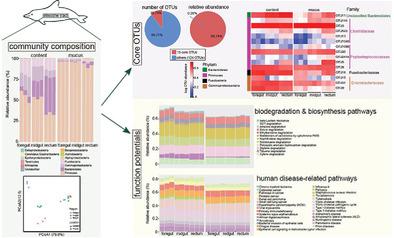当前位置:
X-MOL 学术
›
Integr. Zool.
›
论文详情
Our official English website, www.x-mol.net, welcomes your feedback! (Note: you will need to create a separate account there.)
The intestinal microbiome of an Indo‐Pacific humpback dolphin (Sousa chinensis) stranded near the Pearl River Estuary, China
Integrative Zoology ( IF 3.3 ) Pub Date : 2020-08-06 , DOI: 10.1111/1749-4877.12477 Xiaoling Wan 1 , Jia Li 1, 2 , Zhaolong Cheng 1, 3 , Mengxue Ao 1 , Renmao Tian 4, 5 , Richard William McLaughlin 1, 6 , Jinsong Zheng 1 , Ding Wang 1
Integrative Zoology ( IF 3.3 ) Pub Date : 2020-08-06 , DOI: 10.1111/1749-4877.12477 Xiaoling Wan 1 , Jia Li 1, 2 , Zhaolong Cheng 1, 3 , Mengxue Ao 1 , Renmao Tian 4, 5 , Richard William McLaughlin 1, 6 , Jinsong Zheng 1 , Ding Wang 1
Affiliation

|
The mammalian intestinal microbiome is critical for host health and disease resistance. However, the cetacean intestinal microbiota remains relatively unexplored. By using high‐throughput 16S rRNA gene sequencing, we analyzed intestinal bacterial samples from an Indo‐pacific humpback dolphin (Sousa chinensis) stranded near the Pearl River Estuary in China. The samples included 3 anatomical regions (foregut, midgut, and rectum) and 2 anatomical locations (content and mucus). Our analyses revealed that the dolphin intestinal bacteria contained 139 operational taxonomic units (OTUs), dominated at the phyla level by Firmicutes (47.05% in the content; 94.77% in the mucus), followed by Bacteroidetes (23.63% in the content; 1.58% in the mucus) and Gammaproteobacteria (14.82% in the content; 2.05% in the mucus). The intestinal bacteria had a small core community (15 OTUs, accounting for 99.74% of the reads), some of which could be potentially pathogenic to both human and dolphins. As an alternative to sampling the dolphin intestinal bacteria, fecal sampling could be used. Additionally, function potentials such as, xenobiotics biodegradation, beta‐lactam resistance, and human disease‐related pathways, were detected in the dolphin intestinal bacteria. These findings provide the first baseline knowledge of the intestinal microbiome of the Indo‐Pacific humpback dolphin, which may offer new insights into cetacean conservation by using microbial surveillance.
更新日期:2020-08-06



























 京公网安备 11010802027423号
京公网安备 11010802027423号